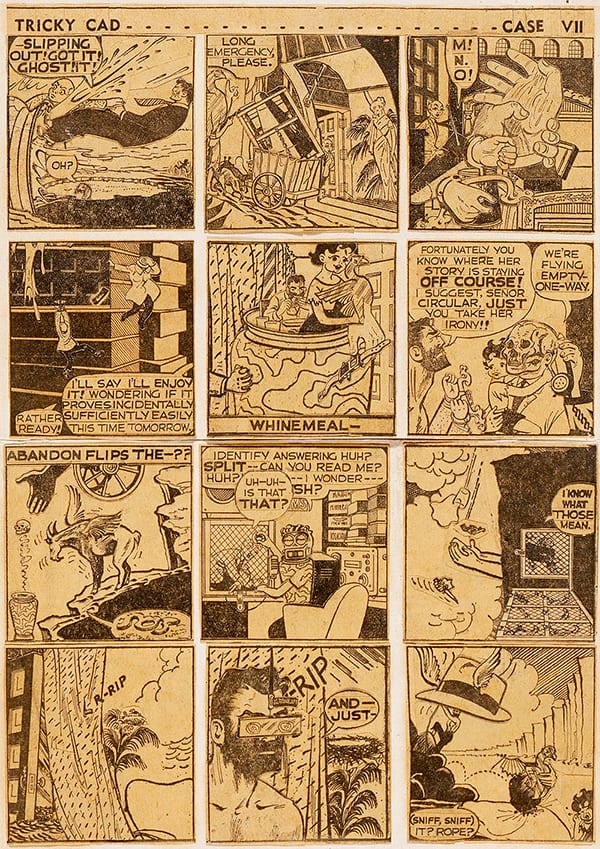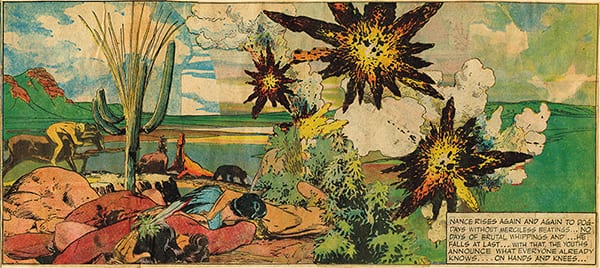Even among those familiar with contemporary art history, the relationship between comics and so-called “high art” is often limited to a few superficial talking points, boiling down to the early token recognition of George Herriman’s Krazy Kat as great art and the wholesale and arguably condescending swipes of the Pop artists – particularly Roy Lichtenstein. Fortunately for all involved, the story is more complicated than that. Artists like the late Swede Oyvind Fahlstrom or Scotland’s Eduardo Paolozzi created complex works that honored original comic creators while looking to the medium’s innovations in pictographic language as extensions of the parameters of Modern Art. Europe was way ahead of America in recognizing the medium’s legitimacy, in a broad popular sense as well as in academia and the art world.
But there were pockets of brilliance in the USA too. One of the greatest-ever fine art interrogations of the funny pages has to have been Tricky Cad, created by the San Francisco artist Jess (Collins) between 1952-1959. An eight-episode series of cut-ups made entirely out of fragments of Chester Gould’s Dick Tracy, the five known extant collages have been collected and reproduced at a legible size for the first time ever in O! Tricky Cad & Other Jessoterica edited by LA-based art writer Michael Duncan and published by Siglio Press -- who also released a stellar 2008 collection of NY artist Joe Brainard’s decades-long body of work deconstructing Ernie Bushmiller’s Nancy.

Tricky Cad is remarkable on a number of levels. For starters, Jess takes advantage of the ultra clean-line graphics of Gould’s grotesque cop-opera to amp up the pictorial weirdness to 11. Almost every panel stands as a tiny surrealist composition reminiscent of (and clearly inspired by) German Dadaist Max Ernst’s seminal collaged graphic novels of the 1920s and '30s. Perspective and scale are thrown to the wind. A giant hand holding a key protrudes through a doorway into a dark and frozen meat locker, asking “Too High?” But in spite of its dream logic, Jess’s distortions of appropriated mass media imagery are at once more intelligible, more culturally current, and more laugh-out-loud absurd than Ernst’s.
A large part of that is due to the inclusion of words – Gould’s snappy, hardboiled dialog and Crimestopper Tips are subjected to a fragmentation and rearrangement whose results oscillate between incantory poetics and slapstick nonsense -- with occasional bursts of satiric social and political commentary. As a gay man who had quit a lucrative career as a chemist working on nuclear weapons in favor of art, Jess possessed an impeccably alienated POV regarding '50s mainstream culture. A healthy skepticism toward the authority of language permeates his work.
But in addition to uncovering the hidden beatnik glossolalia in Gould’s staccato noir storytelling - adding a Dada twist missing from Ernst’s wordless tableaux - Tricky Cad was Modern in a way that Ernst’s patched-together insta-nostalgia Victorian engravings never tried to be, not just because they were assembled from contemporary newspapers.
Gould’s Dick Tracy was profoundly influenced by the pictographic possibilities of Modernist formalism – geometric reduction, simplified color, aggressively linear compositions that eschewed photorealist nuance for an almost industrial graphic design immediacy – Gould had a primitivist magpie eye for purified ways of picture-making.
By breaking the linear narrative agenda of the original strips, but keeping the graphic vocabulary intact, Jess identifies and brings to the forefront Gould’s inherent avant-gardism. This undoubtedly would send Chester spinning in his grave -- if he hadn’t been very much alive and kicking at the time the collages were made, in the middle of a long slide to the same cultural phantom zone occupied by Al Capp.

The Tricky Cad collages amount to only about 20 pages of the book’s 192. Several other comic strip collages are included, as well as a bunch of Jess’s zine-like collage publications, and his unfailingly dazzling “paste-up” collages whose laborious intricacy remains astounding. As an historic landmark of comic book/Fine Art intercourse, Tricky Cad is about as perfect a mutual orgasm as you could record, but as the individual response of a singular intelligence to the pictographic possibilities of his era, it is timeless.







